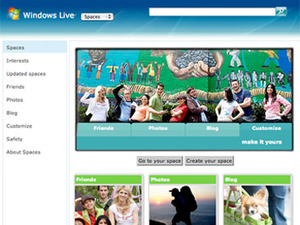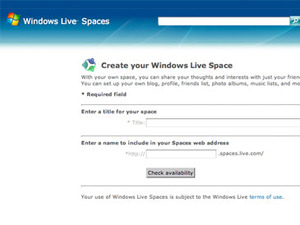
The ‘people’ category is more geared towards the social aspect of the site, as contains matchmaking subcategories among others (including even a liftsharing section). The whole interface is pretty sleek and certainly hints at the Web 2.0 feel that Microsoft has been trying to introduce into its services recently. However Live Expo isn’t as graphic heavy as eBay, and the basic design seems to reflect the comparatively low amount of features that Expo has. Being designed from the ground up does mean that some sections become easier to navigate, with ‘for sale’ and ‘wanted’ options being merely tabs instead of separate sites.
One of the nicest features of Live Expo, however, is the way it handles the ‘geographical’ side of things. Each user account has the precise location stored on it, and when browsing you can filter or sort by precise distances, which is especially handy when browsing for items which require pick-up. If you prefer to have a visual overview of available items, the ‘Map results’ option plots every item on a Live Local map in relation to yourself, and then allows you click on the pinpointed options to be taken to the product page. If you do decide to pursue an item, you can simply have to chose ‘get driving directions’ on the product page and Expo will create a full route plan for you, again using Live Local.

 Of course, trying to evaluate a whole shopping service in the space of a few paragraphs is a tricky task to say the least, so rest assured Live Expo has a lot more to offer than the few features I’ve explored already, such as some great integration with Live Messenger and much longer listing times (currently up to 8 weeks). What Microsoft is trying to achieve with Live Expo is a mystery to many people, as a corporation of its size certainly wouldn’t be naïve enough to think it can single-handedly replace eBay as the average internet user’s favourite marketplace, although the service does offer some advantages.
Of course, trying to evaluate a whole shopping service in the space of a few paragraphs is a tricky task to say the least, so rest assured Live Expo has a lot more to offer than the few features I’ve explored already, such as some great integration with Live Messenger and much longer listing times (currently up to 8 weeks). What Microsoft is trying to achieve with Live Expo is a mystery to many people, as a corporation of its size certainly wouldn’t be naïve enough to think it can single-handedly replace eBay as the average internet user’s favourite marketplace, although the service does offer some advantages.
Integration with Live Spaces should mean that people are more likely to ‘stumble’ upon listings and find them out of chance rather than intentionally looking for items all the time, and the cost-free aspect of the service means that current eBay junkies aren’t losing anything by listing their item(s) on Expo as well. Nevertheless, the push for community-based services has been met with a lot of support and, with a few extra touches, Windows Live Expo could find its own gap in the market, as well as providing some much needed competition to eBay.
Soapbox on MSN video:
If you managed to survive the marathon of literature on Live Expo, then you’ll be happy to hear I’ll keep this one short. MSN Soapbox is a user-uploaded video service, just like YouTube really, which hopes to offer users the opportunity to share videos and find ones of personal interest. It’s interesting to note how Microsoft has kept Soapbox away from the Windows Live branding, most probably because it would prefer to associate video content with its MSNBC cable channel. Having only recently been opened up to the public for beta testing, Soapbox’s interface is a stark contrast to the flat and basic graphics of YouTube, and instead offers a more ‘daring’ design which employs flash menus and roll-overs to create a more leisurely approach to the service.

 The actual video player offers little in the way of innovation, with a familiar video player and controls accompanied by a tabbed footing section which has URL’s for embedding or sharing the video (a key ingredient to YouTube’s success), as well as room for comments and ‘tags’ (a set of keywords which anyone can add to or click on to search for other videos sharing that tag). The video player is placed statically on the right hand side of the screen and isn’t affected by the other sections in the site, allowing users to browse through other categories or searches, or even upload another video whilst watching the same video without interruption.
The actual video player offers little in the way of innovation, with a familiar video player and controls accompanied by a tabbed footing section which has URL’s for embedding or sharing the video (a key ingredient to YouTube’s success), as well as room for comments and ‘tags’ (a set of keywords which anyone can add to or click on to search for other videos sharing that tag). The video player is placed statically on the right hand side of the screen and isn’t affected by the other sections in the site, allowing users to browse through other categories or searches, or even upload another video whilst watching the same video without interruption.
Uploading videos is relatively simple task, and Microsoft will allow you to upload clips up to 100MB in size being in any of the AVI, ASF, WMV, MOV, MPEG 1/2/4, 3GPP, or DV file formats. If you want to keep track of the most popular or newest videos, or even a particular search term/tag, you can subscribe to a specific RSS feed regarding your query, or add it straight to your Live.com or myMSN account.
Again, it’s difficult to see how Microsoft plans to market Soapbox for MSN video when people are already happy using YouTube, which currently commands 43% of the online video market and now has Google’s support to help it move on even further. Yet looking at the grand scheme of things, Microsoft really needed to start providing somewhere for users to share videos if it were to be taken seriously, as the integration with Live Spaces means videos can be added to users’ personal domains much in the way that MySpace does.
Trying Soapbox is really another example of Microsoft’s social networking drive, and I don’t see any other company doing more than the guys at Redmond to help push through the Web 2.0 mantra at the moment. Whilst a lot of individual companies may offer more popular or well-known services, Microsoft’s Live initiative is seeing all of the different types of services available moulded into one ‘super-community’ which all runs off one Windows Live ID user base, meaning that cross-referencing data from all the various services is easier and more structured. Whilst Google’s takeover of YouTube means the search giant is coming closer to Microsoft in terms of its offerings to social-networking, I don’t think anyone can really complain that Gates and co are doing a bad job.
One of the nicest features of Live Expo, however, is the way it handles the ‘geographical’ side of things. Each user account has the precise location stored on it, and when browsing you can filter or sort by precise distances, which is especially handy when browsing for items which require pick-up. If you prefer to have a visual overview of available items, the ‘Map results’ option plots every item on a Live Local map in relation to yourself, and then allows you click on the pinpointed options to be taken to the product page. If you do decide to pursue an item, you can simply have to chose ‘get driving directions’ on the product page and Expo will create a full route plan for you, again using Live Local.


Integration with Live Spaces should mean that people are more likely to ‘stumble’ upon listings and find them out of chance rather than intentionally looking for items all the time, and the cost-free aspect of the service means that current eBay junkies aren’t losing anything by listing their item(s) on Expo as well. Nevertheless, the push for community-based services has been met with a lot of support and, with a few extra touches, Windows Live Expo could find its own gap in the market, as well as providing some much needed competition to eBay.
Soapbox on MSN video:
If you managed to survive the marathon of literature on Live Expo, then you’ll be happy to hear I’ll keep this one short. MSN Soapbox is a user-uploaded video service, just like YouTube really, which hopes to offer users the opportunity to share videos and find ones of personal interest. It’s interesting to note how Microsoft has kept Soapbox away from the Windows Live branding, most probably because it would prefer to associate video content with its MSNBC cable channel. Having only recently been opened up to the public for beta testing, Soapbox’s interface is a stark contrast to the flat and basic graphics of YouTube, and instead offers a more ‘daring’ design which employs flash menus and roll-overs to create a more leisurely approach to the service.


Uploading videos is relatively simple task, and Microsoft will allow you to upload clips up to 100MB in size being in any of the AVI, ASF, WMV, MOV, MPEG 1/2/4, 3GPP, or DV file formats. If you want to keep track of the most popular or newest videos, or even a particular search term/tag, you can subscribe to a specific RSS feed regarding your query, or add it straight to your Live.com or myMSN account.
Again, it’s difficult to see how Microsoft plans to market Soapbox for MSN video when people are already happy using YouTube, which currently commands 43% of the online video market and now has Google’s support to help it move on even further. Yet looking at the grand scheme of things, Microsoft really needed to start providing somewhere for users to share videos if it were to be taken seriously, as the integration with Live Spaces means videos can be added to users’ personal domains much in the way that MySpace does.
Trying Soapbox is really another example of Microsoft’s social networking drive, and I don’t see any other company doing more than the guys at Redmond to help push through the Web 2.0 mantra at the moment. Whilst a lot of individual companies may offer more popular or well-known services, Microsoft’s Live initiative is seeing all of the different types of services available moulded into one ‘super-community’ which all runs off one Windows Live ID user base, meaning that cross-referencing data from all the various services is easier and more structured. Whilst Google’s takeover of YouTube means the search giant is coming closer to Microsoft in terms of its offerings to social-networking, I don’t think anyone can really complain that Gates and co are doing a bad job.

MSI MPG Velox 100R Chassis Review
October 14 2021 | 15:04








Want to comment? Please log in.